1、中国古代加密
看一个小故事 , 看看古人如何加密和解密:
公元683年,唐中宗即位。随后,武则天废唐中宗,立第四子李旦为皇帝,但朝政大事均由她自己专断。
裴炎、徐敬业和骆宾王等人对此非常不满。徐敬业聚兵十万,在江苏扬州起兵。裴炎做内应,欲以拆字手段为其传递秘密信息。后因有人告密,裴炎被捕,未发出的密信落到武则天手中。这封密信上只有“青鹅”二字,群臣对此大惑不解。
武则天破解了“青鹅”的秘密:“青”字拆开来就是“十二月”,而“鹅”字拆开来就是“我自与”。密信的意思是让徐敬业、骆宾王等率兵于十二月进发,裴炎在内部接应。“青鹅”破译后,裴炎被杀。接着,武则天派兵击败了徐敬业和骆宾王。

2、外国加密
在密码学中,恺撒密码是一种最简单且最广为人知的加密技术。
凯撒密码最早由古罗马军事统帅盖乌斯·尤利乌斯·凯撒在军队中用来传递加密信息,故称凯撒密码。这是一种位移加密方式,只对26个字母进行位移替换加密,规则简单,容易破解。下面是位移1次的对比:

将明文字母表向后移动1位,A变成了B,B变成了C……,Z变成了A。同理,若将明文字母表向后移动3位:

则A变成了D,B变成了E……,Z变成了C。
字母表最多可以移动25位。凯撒密码的明文字母表向后或向前移动都是可以的,通常表述为向后移动,如果要向前移动1位,则等同于向后移动25位,位移选择为25即可。
它是一种替换加密的技术,明文中的所有字母都在字母表上向后(或向前)按照一个固定数目进行偏移后被替换成密文。
例如,当偏移量是3的时候,所有的字母A将被替换成D,B变成E,以此类推。
这个加密方法是以恺撒的名字命名的,当年恺撒曾用此方法与其将军们进行联系。
恺撒密码通常被作为其他更复杂的加密方法中的一个步骤。
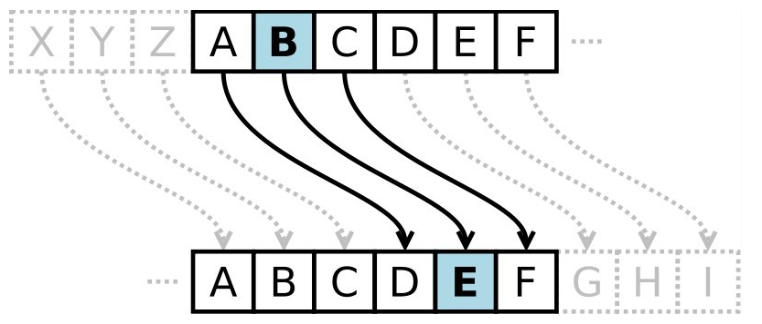
简单来说就是当秘钥为n,其中一个待加密字符ch,加密之后的字符为ch+n,当ch+n超过’z’时,回到’a’计数。
3、凯撒位移加密
public class KaiserDemo {
public static void main(String[] args) {
String input = "Hello world";
// 往右边移动3位
int key = 3;
// 用来拼接
StringBuilder sb = new StringBuilder();
// 字符串转换成字节数组
char[] chars = input.toCharArray();
for (char c : chars) {
int asciiCode = c;
// 移动3位
asciiCode = asciiCode + key;
char newChar = (char) asciiCode;
sb.append(newChar);
}
System.out.println(sb.toString());
}
}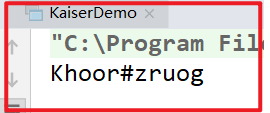
4、凯撒加密和解密
public class KaiserDemo {
public static void main(String[] args) {
String orignal = "Hello world";
// 往右边偏移三位
int key = 3;
// 选中我即将抽取的代码,按快捷键Ctrl + Alt + M
String encryptKaiser = encryptKaiser(orignal,key);
System.out.println("加密:" + encryptKaiser);
String decryptKaiser = decryptKaiser(encryptKaiser,key);
System.out.println("解密:" + decryptKaiser);
}
/**
* 使用凯撒加密方式解密数据
*
* @param encryptedData :密文
* @param key :密钥
* @return : 源数据
*/
public static String decryptKaiser(String encryptedData, int key) {
// 将字符串转为字符数组
char[] chars = encryptedData.toCharArray();
StringBuilder sb = new StringBuilder();
for (char aChar : chars) {
// 获取字符的ASCII编码
int asciiCode = aChar;
// 偏移数据
asciiCode -= key;
// 将偏移后的数据转为字符
char result = (char) asciiCode;
// 拼接数据
sb.append(result);
}
return sb.toString();
}
/**
* 使用凯撒加密方式加密数据
*
* @param orignal :原文
* @param key :密钥
* @return :加密后的数据
*/
public static String encryptKaiser(String orignal, int key) {
// 将字符串转为字符数组
char[] chars = orignal.toCharArray();
StringBuilder sb = new StringBuilder();
for (char aChar : chars) {
// 获取字符的ascii编码
int asciiCode = aChar;
// 偏移数据
asciiCode += key;
// 将偏移后的数据转为字符
char result = (char) asciiCode;
// 拼接数据
sb.append(result);
}
return sb.toString();
}
}5、频度分析法破解恺撒加密
密码棒
公元前5世纪的时候,斯巴达人利用一根木棒,缠绕上皮革或者羊皮纸,在上面横向写下信息,解下这条皮带。展开来看,这长串字母没有任何意义。
比如这样:
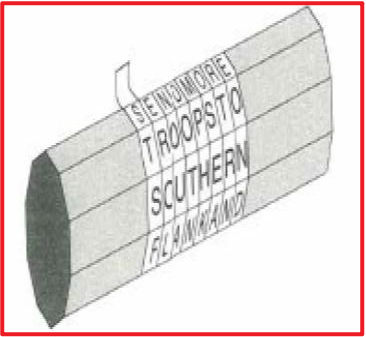
信差可以将这条皮带当成腰带,系在腰上。
比如这样:
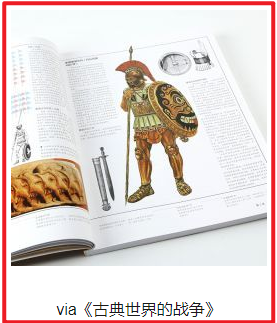
然后收件人将这条皮带缠绕在相同的木棒上,就能恢复信息了。
前404年,一位遍体鳞伤的信差来到斯巴达将领利桑德面前,这趟波斯之旅只有他和四位同伴幸存,利桑德接下腰带,缠绕到他的密码棒上,得知波斯的发那巴祖斯准备侵袭他,多亏密码棒利桑德才能够预先防范,击退敌军。
6、频率分析解密法
密码棒是不是太简单了些?
加密者选择将组成信息的字母替代成别的字母,比如说将a写成1,这样就不能被解密者直接拿到信息了。
这难不倒解密者,以英文字母为例,为了确定每个英文字母的出现频率,分析一篇或者数篇普通的英文文章,英文字母出现频率最高的是e,接下来是t,然后是a……,然后检查要破解的密文,也将每个字母出现的频率整理出来,假设密文中出现频率最高的字母是j,那么就可能是e的替身,如果密码文中出现频率次高的但是P,那么可能是t的替身,以此类推便就能解开加密信息的内容。这就是频率分析法。
- 将明文字母的出现频率与密文字母的频率相比较的过程
- 通过分析每个符号出现的频率而轻易地破译代换式密码
- 在每种语言中,冗长的文章中的字母表现出一种可对之进行分辨的频率。
- e是英语中最常用的字母,其出现频率为八分之一
运行 FrequencyAnalysis.java 用来统计每个字符出现的次数
article:
My father was a self-taught mandolin player. He was one of the best string instrument players in our town. He could not read music, but if he heard a tune a few times, he could play it. When he was younger, he was a member of a small country music band. They would play at local dances and on a few occasions would play for the local radio station. He often told us how he had auditioned and earned a position in a band that featured Patsy Cline as their lead singer. He told the family that after he was hired he never went back. Dad was a very religious man. He stated that there was a lot of drinking and cursing the day of his audition and he did not want to be around that type of environment.
Occasionally, Dad would get out his mandolin and play for the family. We three children: Trisha, Monte and I, George Jr., would often sing along. Songs such as the Tennessee Waltz, Harbor Lights and around Christmas time, the well-known rendition of Silver Bells. "Silver Bells, Silver Bells, its Christmas time in the city" would ring throughout the house. One of Dad's favorite hymns was "The Old Rugged Cross". We learned the words to the hymn when we were very young, and would sing it with Dad when he would play and sing. Another song that was often shared in our house was a song that accompanied the Walt Disney series: Davey Crockett. Dad only had to hear the song twice before he learned it well enough to play it. "Davey, Davey Crockett, King of the Wild Frontier" was a favorite song for the family. He knew we enjoyed the song and the program and would often get out the mandolin after the program was over. I could never get over how he could play the songs so well after only hearing them a few times. I loved to sing, but I never learned how to play the mandolin. This is something I regret to this day.
Dad loved to play the mandolin for his family he knew we enjoyed singing, and hearing him play. He was like that. If he could give pleasure to others, he would, especially his family. He was always there, sacrificing his time and efforts to see that his family had enough in their life. I had to mature into a man and have children of my own before I realized how much he had sacrificed.
I joined the United States Air Force in January of 1962. Whenever I would come home on leave, I would ask Dad to play the mandolin. Nobody played the mandolin like my father. He could touch your soul with the tones that came out of that old mandolin. He seemed to shine when he was playing. You could see his pride in his ability to play so well for his family.
When Dad was younger, he worked for his father on the farm. His father was a farmer and sharecropped a farm for the man who owned the property. In 1950, our family moved from the farm. Dad had gained employment at the local limestone quarry. When the quarry closed in August of 1957, he had to seek other employment. He worked for Owens Yacht Company in Dundalk, Maryland and for Todd Steel in Point of Rocks, Maryland. While working at Todd Steel, he was involved in an accident. His job was to roll angle iron onto a conveyor so that the welders farther up the production line would have it to complete their job. On this particular day Dad got the third index finger of his left hand mashed between two pieces of steel. The doctor who operated on the finger could not save it, and Dad ended up having the tip of the finger amputated. He didn't lose enough of the finger where it would stop him picking up anything, but it did impact his ability to play the mandolin.
After the accident, Dad was reluctant to play the mandolin. He felt that he could not play as well as he had before the accident. When I came home on leave and asked him to play he would make excuses for why he couldn't play. Eventually, we would wear him down and he would say "Okay, but remember, I can't hold down on the strings the way I used to" or "Since the accident to this finger I can't play as good". For the family it didn't make any difference that Dad couldn't play as well. We were just glad that he would play. When he played the old mandolin it would carry us back to a cheerful, happier time in our lives. "Davey, Davey Crockett, King of the Wild Frontier", would again be heard in the little town of Bakerton, West Virginia.
In August of 1993 my father was diagnosed with inoperable lung cancer. He chose not to receive chemotherapy treatments so that he could live out the rest of his life in dignity. About a week before his death, we asked Dad if he would play the mandolin for us. He made excuses but said "okay". He knew it would probably be the last time he would play for us. He tuned up the old mandolin and played a few notes. When I looked around, there was not a dry eye in the family. We saw before us a quiet humble man with an inner strength that comes from knowing God, and living with him in one's life. Dad would never play the mandolin for us again. We felt at the time that he wouldn't have enough strength to play, and that makes the memory of that day even stronger. Dad was doing something he had done all his life, giving. As sick as he was, he was still pleasing others. Dad sure could play that Mandolin!Util:
public class Util {
public static void print(byte[] bytes) {
StringBuffer sb = new StringBuffer();
for (int i = 0; i < bytes.length; i++) {
sb.append(bytes[i]).append(" ");
}
System.out.println(sb);
}
public static String file2String(String path) throws IOException {
FileReader reader = new FileReader(new File(path));
char[] buffer = new char[1024];
int len = -1;
StringBuffer sb = new StringBuffer();
while ((len = reader.read(buffer)) != -1) {
sb.append(buffer, 0, len);
}
return sb.toString();
}
public static void string2File(String data, String path){
FileWriter writer = null;
try {
writer = new FileWriter(new File(path));
writer.write(data);
} catch (Exception e) {
e.printStackTrace();
}finally {
if (writer != null) {
try {
writer.close();
} catch (IOException e) {
e.printStackTrace();
}
}
}
}
public static String inputStream2String(InputStream in) throws IOException {
int len = -1;
byte[] buffer = new byte[1024];
ByteArrayOutputStream baos = new ByteArrayOutputStream();
while((len = in.read(buffer)) != -1) {
baos.write(buffer, 0, len);
}
baos.close();
return baos.toString("UTF-8");
}
}FrequencyAnalysis:
/**
* 频率分析法破解凯撒密码
*/
public class FrequencyAnalysis {
//英文里出现次数最多的字符
private static final char MAGIC_CHAR = 'e';
//破解生成的最大文件数
private static final int DE_MAX_FILE = 4;
public static void main(String[] args) throws Exception {
//测试1,统计字符个数
printCharCount("article.txt");
//加密文件
int key = 3;
//encryptFile("article.txt", "article_en.txt", key);
//读取加密后的文件
// String artile = Util.file2String("article_en.txt");
//解密(会生成多个备选文件)
// decryptCaesarCode(artile, "article_de.txt");
}
public static void printCharCount(String path) throws IOException{
String data = Util.file2String(path);
List<Entry<Character, Integer>> mapList = getMaxCountChar(data);
for (Entry<Character, Integer> entry : mapList) {
//输出前几位的统计信息
System.out.println("字符'" + entry.getKey() + "'出现" + entry.getValue() + "次");
}
}
public static void encryptFile(String srcFile, String destFile, int key) throws IOException {
String artile = Util.file2String(srcFile);
//加密文件
String encryptData = KaiserDemo.encrypt(artile, key);
//保存加密后的文件
Util.string2File(encryptData, destFile);
}
/**
* 破解凯撒密码
* @param input 数据源
* @return 返回解密后的数据
*/
public static void decryptCaesarCode(String input, String destPath) {
int deCount = 0;//当前解密生成的备选文件数
//获取出现频率最高的字符信息(出现次数越多越靠前)
List<Entry<Character, Integer>> mapList = getMaxCountChar(input);
for (Entry<Character, Integer> entry : mapList) {
//限制解密文件备选数
if (deCount >= DE_MAX_FILE) {
break;
}
//输出前几位的统计信息
System.out.println("字符'" + entry.getKey() + "'出现" + entry.getValue() + "次");
++deCount;
//出现次数最高的字符跟MAGIC_CHAR的偏移量即为秘钥
int key = entry.getKey() - MAGIC_CHAR;
System.out.println("猜测key = " + key + ", 解密生成第" + deCount + "个备选文件" + "\n");
String decrypt = KaiserDemo.decrypt(input, key);
String fileName = "de_" + deCount + destPath;
Util.string2File(decrypt, fileName);
}
}
//统计String里出现最多的字符
public static List<Entry<Character, Integer>> getMaxCountChar(String data) {
Map<Character, Integer> map = new HashMap<Character, Integer>();
char[] array = data.toCharArray();
for (char c : array) {
if(!map.containsKey(c)) {
map.put(c, 1);
}else{
Integer count = map.get(c);
map.put(c, count + 1);
}
}
//输出统计信息
/*for (Entry<Character, Integer> entry : map.entrySet()) {
System.out.println(entry.getKey() + "出现" + entry.getValue() + "次");
}*/
//获取获取最大值
int maxCount = 0;
for (Entry<Character, Integer> entry : map.entrySet()) {
//不统计空格
if (/*entry.getKey() != ' ' && */entry.getValue() > maxCount) {
maxCount = entry.getValue();
}
}
//map转换成list便于排序
List<Entry<Character, Integer>> mapList = new ArrayList<Map.Entry<Character,Integer>>(map.entrySet());
//根据字符出现次数排序
Collections.sort(mapList, new Comparator<Entry<Character, Integer>>(){
@Override
public int compare(Entry<Character, Integer> o1,
Entry<Character, Integer> o2) {
return o2.getValue().compareTo(o1.getValue());
}
});
return mapList;
}
}
运行 FrequencyAnalysis.java 里面 main 函数里面的 encryptFile 方法 对程序进行加密
public static void main(String[] args) throws Exception {
//测试1,统计字符个数
//printCharCount("article.txt");
//加密文件
int key = 3;
encryptFile("article.txt", "article_en.txt", key);
//读取加密后的文件
// String artile = Util.file2String("article_en.txt");
//解密(会生成多个备选文件)
// decryptCaesarCode(artile, "article_de.txt");
}在根目录会生成一个 article_en.txt 文件,然后我们统计这个文件当中每个字符出现的次数
public static void main(String[] args) throws Exception {
//测试1,统计字符个数
printCharCount("article_en.txt");
//加密文件
int key = 3;
//encryptFile("article.txt", "article_en.txt", key);
//读取加密后的文件
// String artile = Util.file2String("article_en.txt");
//解密(会生成多个备选文件)
// decryptCaesarCode(artile, "article_de.txt");
}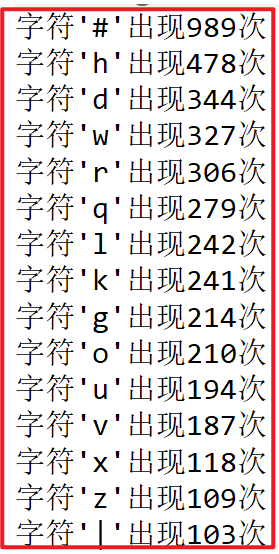
我们来看看 频度分析法如何工作的
public static void main(String[] args) throws Exception {
//测试1,统计字符个数
//printCharCount("article_en.txt");
//加密文件
int key = 3;
//encryptFile("article.txt", "article_en.txt", key);
//读取加密后的文件
String artile = Util.file2String("article_en.txt");
//解密(会生成多个备选文件)
decryptCaesarCode(artile, "article_de.txt");
}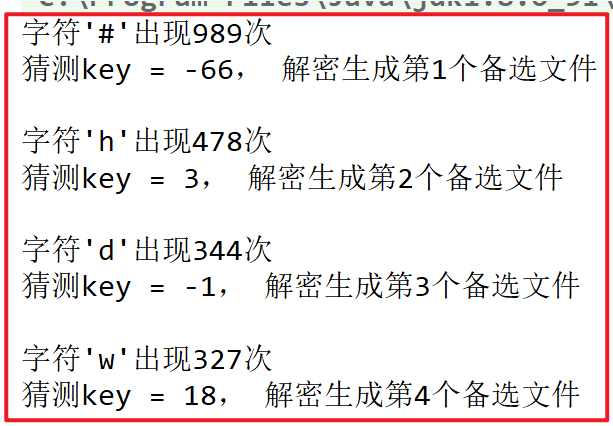
运行结果 # 出现次数最多, 我们知道在英文当中 e 出现的频率是最高的,我们假设现在 # 号,就是 e ,变形而来的 ,我们可以对照 ascii 编码表 ,我们的凯撒加密当中位移是加了一个 key ,所以我们 猜测 两个值直接相差 -66 ,我们现在就以 -66 进行解密 生成一个文件,我们查看第一个文件发现,根本读不懂,所以解密失败,我们在猜测 h 是 e ,h 和 e 之间相差3 ,所以我们在去看第二个解密文件,发现我们可以读懂,解密成功
